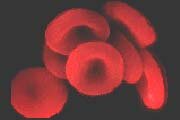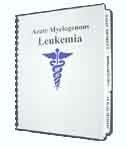 |
||
| HOME | ||
 |
||
| Acute Myelogenous Leukemia (AML) |
||
 |
||
| Other Leukemia Types (ALL / CLL / CML / HCL) |
||
 |
||
| Myelodysplastic Syndrome | ||
 |
||
| Symptoms and Diagnosis | ||
 |
||
| Leukemia Treatment Options | ||
 |
||
| " Chemotherapy | ||
 |
||
| " Blood Stem Cell Transplants | ||
 |
||
| " Radiation and Surgery | ||
 |
||
| " Chemo Side Effects | ||
 |
||
| " Clinical Trials Info | ||
 |
||
| " Coping with Leukemia | ||
 |
||
| " What to Ask Your Doctor | ||
 |
||
| Financial Assistance | ||
 |
||
| At Risk Jobs/Exposure | ||
 |
||
| Leukemia Resources | ||
 |
||
| Survivor's Story | ||
 |
||
| Leukemia News | ||
 |
||
|
Search for information:
|
||

|
Leukemia Cancer News - Return to Menu Researchers have documented a novel form of resistance in leukemia cells to an anti-cancer drug 8-Nov-2004 - Researchers at Virginia Commonwealth Universitys Massey Cancer Center have documented a novel form of resistance in leukemia cells to an anti-cancer drug, which could help scientists develop new strategies for treating the disease. Research showed that the activation of the enzyme Lyn increases the expression of Bcl-2, a protein that opposes cell death in chronic myelogenous leukemia, or CML, cells. Once this pathway is activated, Lyn causes the leukemia cells to become resistant to chemotherapeutic drugs, including imatinib mesylate, according to the article published in the Aug. 13, 2004, issue of the Journal of Biological Chemistry. CML is a cancer of the bone marrow caused by a specific genetic abnormality and is one of the most common forms of leukemia. Imatinib mesylate previously has been highly effective in the treatment of CML because it inhibits Bcr/Abl, the primary gene responsible for the leukemia. However, once the Bcr/Abl gene has been inhibited by the drug, in some cases, Lyn becomes activated, thereby altering the regulation of Bcl-2, which causes the leukemia cells to become resistant to imatinib mesylate and other drugs. Researchers examined the molecular profile of human CML cells that had become resistant to imatinib mesylate in association with the loss of Bcr/Abl gene and activation of Lyn. We observed that some leukemia cells experience loss of the Bcr/Abl gene while at the same time exhibiting increased activity of another class of oncogenes, a phenomenon that presumably compensates for the loss of the effects of the Bcr/Abl gene, Grant wrote. The Src kinase family, which includes Lyn, is generally not as susceptible to imatinib mesylate as the Bcr/Abl gene. Lyn is able to promote the survival of CML cells by altering expression of Bcl-2, causing their sensitivity to the drug to become diminished, he said. According to Grant, drug resistance can occur when there is an increased expression of the cancer gene because it becomes more difficult for the drug to inhibit cancer progression. Mutations in Bcr/Abl may also result in drug resistance because the gene structure becomes altered causing the gene to become less susceptible to imatinib mesylate. This seems to be the most common mechanism by which CML cells become resistant to imatinib mesylate. Although imatinib mesylate is effective initially, investigators have found that patients eventually become resistant to the drug, said Grant. This has happened with many static chemotherapeutic agents, which is why there is great interest in developing new approaches to manage drug resistance in patients with CML. If we can determine which gene is responsible for causing a particular cancer, we can target that gene with certain pharmacologic agents, he said. We now have a better understanding of the mechanisms involved with regulating these molecular pathways as well as the development of drug resistance. Consequently, there are opportunities to develop therapeutic strategies that focus, for example, on Bcl-2 regulation. The study was supported by grants from the National Cancer Institute, the Department of Defense, and the Leukemia and Lymphoma Society of America. What Causes MDS? David T. Bowen, MD INTRODUCTION Amongst the most frequent questions asked by patients soon after the diagnosis of MDS (Myelodysplastic Syndrome) are: Why me? MDS is more than one disease The diagnostic process involves categorising an individuals disease into one of five French-American-British (FAB) groups or one of six World Health Organisation (WHO) subgroups (the latter excluding sub-types CMML and the old RAEB-t). These classification systems recognise the differences in the bone marrow appearance and the chromosome abnormalities within the different subgroups of MDS. It does not therefore require a large leap of faith to expect that diseases that look different down a microscope (albeit with certain overlapping similarities), might have different causes. Attempts to study the cause of MDS (epidemiology) have focussed mainly on case-control studies, consisting of questionnaires requesting information about the work and recreational background of MDS patients, compared with a control group of individuals who do not have MDS. Whilst these efforts are commendable, and the best that can be achieved, there are many limitations to such studies. These include recall bias, relying on the patients memory for accuracy, and size of the patient group studied, which in turn determines the power of the study, and hence the confidence that the results are truly accurate and not simply statistical chance. For the purposes of most of these studies, MDS has been considered as one disease, given that the numbers in each subgroup will be small. Who Gets MDS? MDS is a rare disease, whose incidence is 4 per 100,000. The disease becomes more common with increasing age, such that the incidence rises to >30 per 100,000 for people over 70 years of age. Males are more commonly affected than females, although there is some evidence that this is not so for Refractory Anemia with Ring Sideroblasts (RARS) (Dr. U. Germing, personal communication). MDS in children is more infrequent still, and has different characteristics to the adult form. Examples of these differences include the spectrum of FAB/WHO types (RARS and 5q- syndrome are almost never seen in childhood), and of chromosome abnormalities (a higher proportion of children have abnormalities of chromosome 7). How Long Does it Take to Develop MDS? For patients with de novo MDS, the latency time to disease development is unknown. From a biological angle, there will be at least two phases of disease development, namely: 1) the time from the first damage in the bone marrow to the appearance of a change in the blood count, then, 2) the time from the first blood count abnormality to the presentation with clinically relevant disease (usually symptoms of anaemia) (Figure 1). Both are impossible to study systematically at present. For cases of MDS developing after exposure to an agent known or presumed to cause MDS, the latency period varies. This may be from 141 years for different radiation exposures,1 110 years for alkylator cytotoxic drugs,2,3 and more difficult to assess (but up to 30 years?) for benzene.4 Established Causative Factors for MDS Cytotoxic drugs t-MDS/AML constitute <10% all cases of adult MDS however, and the study of t-MDS/AML as a model for the causes of de novo MDS is problematic. Many cases of t-MDS cannot be easily classified due to bone marrow fibrosis (scarring). RARS and CMML are relatively under-represented, and the chromosome abnormalities in t-MDS/AML differ from those of the de novo diseases.3 Survival of patients with t-MDS is also poorer than for de novo MDS. Possible Causative Factors for MDS Radiation Benzene In contrast, exposure to high concentrations of benzene clearly causes bone marrow toxicity, usually aplasia, some of which will progress to MDS and/or AML.7,8 Miscellaneous An exhaustive list of these possible risk factors is therefore not helpful, as many will represent statistical chance or very weak relative risks. Is There an Inherited Tendency to Develop MDS? The vast majority of MDS patients presenting in adulthood have no relatives with the disease, and no obvious inherited disease with a tendency to MDS. 30% children with MDS have other associated abnormalities, and some of these are part of well-recognised syndromes including Fanconi Anaemia, and Blooms Syndrome. How Can We Study the Cause in the Future? A whole new avenue of research into the contribution of genetics to the cause of diseases, involves the study of natural variations in our DNA from person to person. These variations can often lead to changes in the function of cells, and may therefore affect the natural functions of a cell, such as neutralising toxic chemicals that enter the body. To date, no definite natural variation in a gene has been associated with increasing the risk of developing MDS, but this field is only in its infancy. Large numbers of patient samples are needed for such studies, particularly in MDS, where these large numbers are required for each of the FAB/WHO groups. This initiative requires the development of large Biobanks, married to high-quality registries of clinical and laboratory information cataloguing the characteristics of each patients disease. Conclusion Despite more than a decade of dedicated effort from epidemiologists, clinicians and scientists, the cause of MDS remains largely unknown. It is inevitable that the different subtypes of MDS will have different causes. We must use the little high-quality demographic data (Who gets MDS?) to develop hypotheses, and test these in a combination of clinical and molecular epidemiology studies, which by definition will need to involve very large patient numbers. National and international collaborative efforts are underway to attempt to achieve this. REFERENCES Moloney WC. Radiogenic leukemia revisited. Blood. 1987;70:905908. Epidemiology: The study of frequency and cause of disease. http://www.mds-foundation.org/
|
|||||||||||||||||||
|
|


